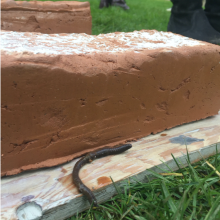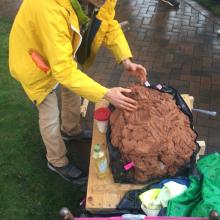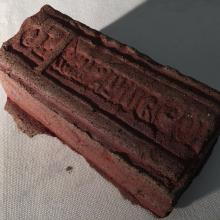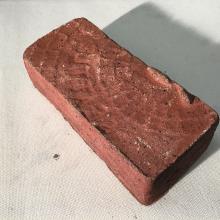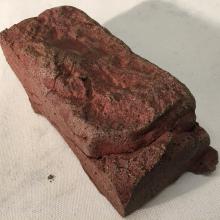During the Winter Quarter of 2020, the one whose final week was memorably interrupted by the university’s sudden closure following the belated recognition of the widespread transmission of the novel coronavirus throughout Washington state, I happened to be teaching a course on the end of the world. “Cultures of Extinction (The Arts of Living on a Climate-changed Planet),” whose name was borrowed from two of our readings, is a course in what I’ve come to call comparative post-apocalyptic studies.
Many parts of that course stick out to me now in ways that they might not have, had a pandemic not erupted during that course. One of those is a brick-making workshop led by my friend and colleague Michael Swaine. Pedagogical and curricular design debates in the field of German Studies often invoke and promote the “integration” of this or that foreign topic or element into a course, perhaps unconsciously mirroring ethno-nationalist discourses of immigration in Germany and the U.S., but I did not attempt to make a case for integrating a brick-making workshop into my course. With our students’ courses of study increasingly rationalized and with their credits effectively capped, exposure to other practices and forms of study has diminished, and these guest-led meetings are an improvised eddy in their streamlined education.
A brick-making workshop has its place in this course. Assignments are collaborative and project-based—and all are inspired by artist projects that I’ve come across and, in some cases, participated in. And so, when I saw the email from Michael Swaine (subject: “idea of helping your class think about earth and clay”) I of course agreed right away. We try to lead a meeting in each other’s courses every year or so, like this.
The workshop on January 21 happened to coincide with a reading, in Elizabeth Kolbert’s The Sixth Extinction, about a thin stratum of clay in a gorge in Italy that led to the discovery of the K/T mass extinction (the one that led to the extinction of dinosaurs). In addition to Kobert’s image of clay as data, Michael Swaine shared with us scenes from Harun Farocki’s Zum Vergleich / In Comparison, a documentary film from 2009 about different traditions of brick production and whose synopsis reads: Bricks are the resonating foundations of society. Bricks are simply very long-playing records. Like records, they appear in series, but every brick is slightly different – not just another brick in the wall. Bricks create spaces, organize social relations and store knowledge about social structures. They resonate in a way that tells us if they are any good. Bricks form the basic sound of our societies, but we haven't yet learned to listen to them.
While we were trekked up to the quad to listen to bricks, Michael Swaine and two graduate students from the school of art, Jia Jia and Jake Fetterman, were busy schlepping several hundred pounds of clay by cart from the Ceramics and Metal Arts building to the Quad.
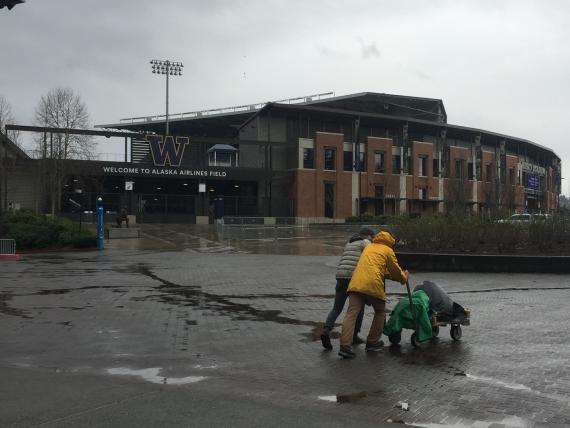
(Photo: Jia Jia)
Incidentally, the clay for these bricks was recycled from Walter McConnell’s incredible clay installation at the Bellevue Arts Museum, Itinerant Edens: A Measure of Disorder. We met this itinerant clay on the quad, and, after a brief demonstration in brickmaking by Michael Swaine and instructions to make bricks that resonate with life and labor, commenced making them. Groups fanned out around the quad, looking for (and listening to) sources of impressions for the clay. It was joyful and almost impertinent to be making bricks at a site that is legendary for having bricks taken from it.
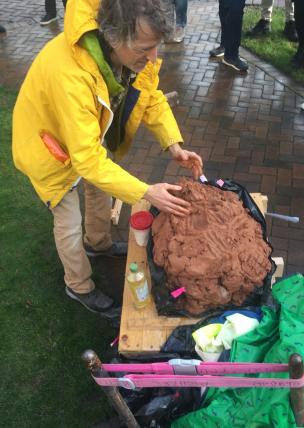
Michael Swaine (Photo: Jason Groves)
After sitting in a neglected corner to the Art Building and then spending some time in a kiln fired to nearly 2300 degrees Fahrenheit during what would turn out to be the final week of classes, there were bricks. In addition to recording the traces of trees, leaves, plants, masonry, and grating, it occurs to me that these collaboratively-fashioned objects record social relations and social structures that were perhaps unremarkable at the time but now seem exceptional and from a bygone epoch—if not extinct, then, like many of the languages we encountered in this course, sleeping, and capable of reawakening some day.
Thanks to Michael, Jia Jia, and Jake for facilitating this workshop!
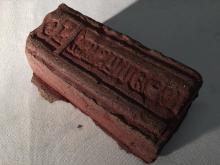


(Brick photos: Michael Swaine)
